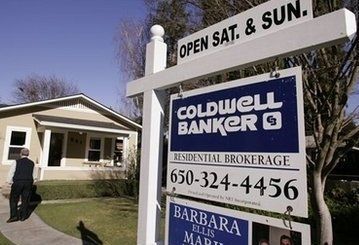
If we take President Obama at his word when he said Tuesday "it is only by understanding how we arrived at this moment that we'll be able to lift ourselves out of this predicament," some forensic accounting is in order as we evaluate our current fiscal and budget priorities. If we dig below the surface of our recent capital allocation policies, we will find massive, perverse housing subsidies weighing down the economy.
Few Americans realize it, but more than predatory lending or deregulation, more than Fannie Mae and Freddie Mac or Wall Street's "innovative" mortgage-backed financial products, decades of runaway housing subsidies are a fundamental cause of the housing bubble. They drove sprawl and oversupply which brought about a collapse in home prices.
In fact, our addiction to overallocating capital to housing remains deeply embedded in our policies today. Policy makers' quasi-religious commitment to housing of any kind has made them the enablers. Weaning ourselves off the addiction is vital to regaining our economic health.
The new White House Office of Urban Affairs may be in a position to help change the pattern, because it needs to fight sprawl in order to revitalize urban economies. But it will have to cross deeply entrenched interests and hidebound practices to do it.
The average citizen always assumed that homeownership paid for itself. But developers have long depended on federal, state and local subsidies to build housing developments, and they lobby hard for them.
Subsidies from Fannie and Freddie, the Federal Housing Administration, the Veterans Administration and mortgage interest deductions played important roles in creating this bubble. State and local subsidies, though less visible, have been huge and pivotal factors in the crisis.
Most of us don't realize our property taxes rarely cover the costs of services and infrastructure that greenfield construction requires. Homeowners pay only a fraction of these costs, while taxpayer-funded municipalities pick up the tab on police, fire, water, schools, roads etc. This has allowed many developers to build and profit from sprawl, at taxpayer expense, while local and state governments have had to use other revenues to cover these costs, or go bust.
Despite the seriousness of the problem, there has been almost no transparent analysis of the fiscal impact of the various giveaways and shortfalls, no connecting of the dots from federal to state to local subsidies to homebuilders. As a result, the true extent of the problem has stayed under the radar.
But one important exception, a 2005 study, estimates government housing subsidies nationally at $84 million dollars a day (over $30 billion a year). From 2000 to 2025, the study projects taxpayers will subsidize transportation, infrastructure and development costs of sprawl for metro Los Angeles, Washington/Baltimore and San Francisco to the tune of $120 billion -- not counting the costs of police, fire, schools, health care, energy and many other big housing-related government costs. Imagine what the true aggregate cost nationally might be.
Now imagine what would have happened if the homebuilding industry had to provide taxpayers with transparent cost-benefit analysis of their projects to qualify for subsidies.
Many projects wouldn't have been built, so there would have been little if any excess housing inventory, and many fewer underwater mortgages and resulting foreclosures. It would have reduced sprawl, making our center cities more vibrant and financially healthier. Many of them probably wouldn't now face the prospect of laying off large numbers of municipal workers, and wouldn't find affordable housing projects unaffordable. Core city asset values would have gone up along with tax revenues and in the suburbs average home size would have remained sustainable, with lower energy usage and shorter gas-guzzling commutes. Government budgets would be much more balanced and our economy would be stronger.
Lack of transparency to date is a tragedy. It has meant that taxpayers inadvertently created the housing bubble and, now that it has burst, will be forced to pay again to clean up the mess.
If, as President Obama urges, taxpayers should be treated as investors, we need transparency to evaluate the cost of and return on our public investment. We must understand how we got into this predicament, start demanding that projects which enjoy taxpayer largesse actually serve the public interest, and that they at least begin to pay their own way. Grants for new projects should require state and local fiscal impact analysis, impact fees and other mechanisms to insure that the true costs of development aren't foisted back on taxpayers.
The Administration's $75 billion anti-foreclosure package has the potential to change untenable mortgages and prevent four million more foreclosures in the short run. We have the new White House Office on Urban Affairs, and a new stimulus package with billions for "shovel-ready" projects. These are welcome steps. But without broad-based transparency, accountability and discipline in allocating public funds, we could end up sowing the seeds of more red ink and future crisis, and all those shovels will only dig us a deeper hole.
